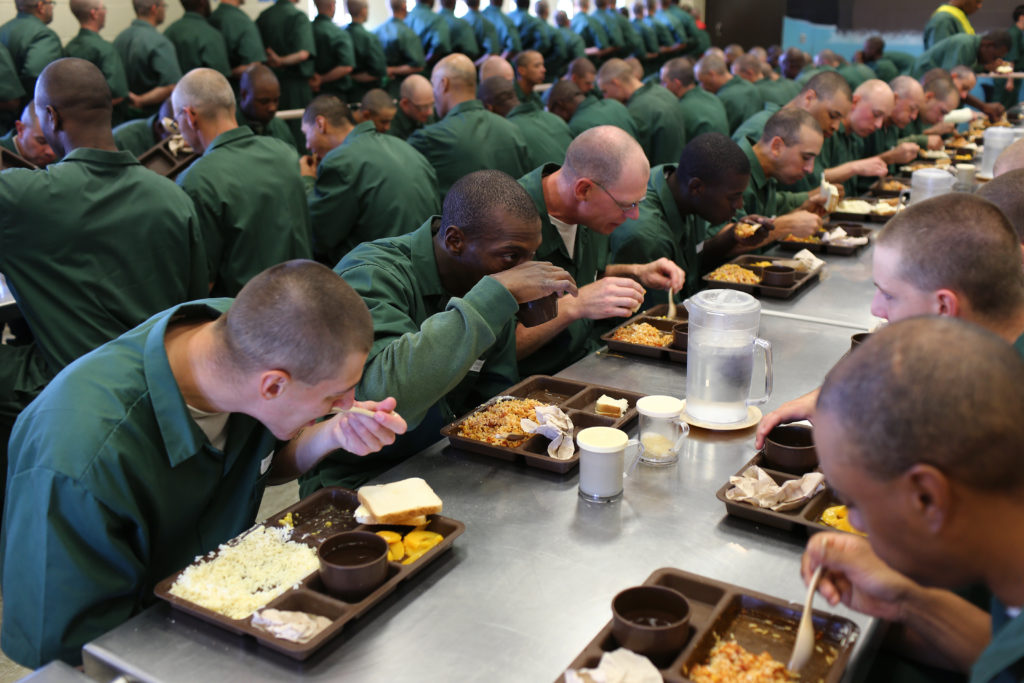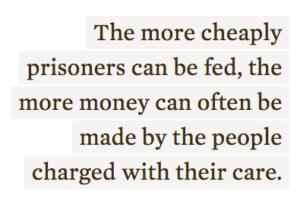New Food Economy: Prison food is making U.S. inmates disproportionately sick

The Lakeview Shock Correctional Facility in upstate New York is one of several “shock camp” prisons run by New York State that allows prisoners convicted of a non-violent crime to dramatically reduce their sentences by volunteering for the six month program. Strict military disciple is combined with intensive physical training, vocational classes, and substance abuse programs. Despite the harsh conditions and corrections officers who are trained drill instructors, the shock camp is popular with (Photo by Andrew Lichtenstein/Corbis via Getty Images)
Lapses in food safety have made U.S. prisoners six times more likely to get a foodborne illness than the general population.
by H. Claire Brown and Joe Fassler | January 3, 2018
This won’t surprise anyone: The food served in correctional institutions is generally not very good. Even though most Americans have never tasted a meal dished up in a correctional kitchen, occasional secondhand glimpses tend to reinforce a common belief that “prison food” is scant, joyless, and unsavory—if not even worse. In August, the Detroit Free Press reported that a prison kitchen worker was fired for refusing to serve rotten potatoes. You can find nightmarish stories about maggots in national outlets like U.S.A. Today. Meanwhile, The Marshall Project’s more thorough, pictorial anatomy of daily correctional fare across the country found that most offerings barely fill a cafeteria tray—let alone a hungry belly. Reports like these reinforce the sense that criminal justice has a gastronomic dimension, that unrelentingly horrid food is a standard feature of the punishment prisoners receive behind bars.
But new evidence suggests that the situation is worse than previously thought, and not just because prison food isn’t winning any James Beard awards. It’s also making inmates sick.
According to a recent study from the Centers for Disease Control and Prevention (CDC), correctional inmates are 6.4 times more likely to suffer from a food-related illness than the general population. The report—which looked at confirmed outbreaks across the country between 1998 and 2014, and is the first update to the data in 20 years—underscores the fact that prison food is more than just a punch line, a flash point, or a gross-out gag on Orange Is the New Black. It’s a hidden public-health crisis.
The study, published in the American Journal of Public Health, found that inmates suffer from foodborne illness at a rate of 45 per 100,000 people annually, compared to only 7 per 100,000 in the general population. And 6 percent of all confirmed outbreak-related cases of foodborne illness in the United States took place in correctional institutions—significant, considering that less than 1 percent of the country’s population is incarcerated. At the same time, “desmoteric” outbreaks—the kind that occur in correctional institutions—were the country’s largest outbreaks in four of the 17 years studied. (In six other years, correctional outbreaks ranked within the top five.) Thirty-seven states reported at least one desmoteric outbreak during the same span.
What’s to blame for the dramatic rates of foodborne illness in jails and prisons? That’s harder to say. In some ways, the CDC study is highly specific about what’s making people sick: The agency determined that Clostridium perfringens and Salmonella were the most common disease-causing agents, for instance, and that tainted poultry products were the most common single culprit. But the data leave us with more questions than answers, since these raw numbers remain mostly uninterpreted. The study doesn’t cover the more systemic factors causing outbreaks in the first place.

Flickr / Philip Cohen
The problems that arise in correctional food service tend to have mundane roots, even if the consequences can be dramatic
Mariel A. Marlow, one of the study’s coauthors, was reluctant to speculate about the underlying cultural, operational, and institutional conditions leading to high rates of illness. “Oversight and regulation of correctional institutions can vary by state and institution, so just to pull out certain factors is a little difficult,” she said. The correctional system is vast and highly variable: When it comes to food, a jail in Reno may be nothing like a federal prison outside New Orleans, and a private prison in Texas may look nothing like its counterpart one county over.
But an issue this widespread still signals the existence of underlying, systemic reasons inmates are six times more likely to be sickened by their food. As it turns out, the problems that arise in correctional food service tend to have mundane roots, even if the consequences can be dramatic. Institutions struggle to enforce basic food-safety standards: Though there are reports of corruption and negligence, the primary factor appears to be that many correctional facilities aren’t equipped to execute the food-handling protocols observed in restaurants and corporate cafeterias. And when mistakes are made, there are inconsistent processes in place to ensure improvement.
Judging from news reports, you might think the main factor causing correctional outbreaks is the poor quality of the food itself. And certainly, a slew of well-publicized lawsuits have accused correctional facilities of buying and serving dodgy ingredients. In May, for instance, a class-action suit was filed against the Oregon Department of Corrections on behalf of current and former inmates, alleging that the state-run food service is so subpar it amounts to cruel and unusual punishment. In recent years, there have been news reports of inmates served rotten chicken tacos, rancid beef, and cake that had been nibbled on by rodents. Meanwhile, earlier this year, a Michigan judge dismissed a suit brought by an inmate who said he’d been repeatedly served moldy bread and spoiled hamburger meat. (According to U.S. District Judge Gordon Quist, the complaint was without merit: In his view, the Eighth Amendment does not entitle prisoners to “tasty or aesthetically pleasing” food, only to a diet that allows them to “maintain normal health.”)
 Examples like these are unfortunately common, said Sara Totonchi of the Southern Center for Human Rights, a nonprofit that advocates on behalf of prisoners. Her organization commonly receives letters from inmates complaining about food quality, she explained by email, including being served rotten food.
Examples like these are unfortunately common, said Sara Totonchi of the Southern Center for Human Rights, a nonprofit that advocates on behalf of prisoners. Her organization commonly receives letters from inmates complaining about food quality, she explained by email, including being served rotten food.
But food-service providers don’t necessarily skimp on ingredients out of a malicious intention to punish prisoners. Instead, there are often systems of perverse incentives in play: The more cheaply prisoners can be fed, the more money can often be made by the people charged with their care.
Many state correctional systems outsource their kitchen operations to private food-service companies, which are usually paid a flat rate per meal to provide a full range of services—from raw ingredients to kitchen equipment and staff. (Two of the biggest players are Trinity and Aramark, which, together, serve hundreds of millions of correctional meals per year.) This arrangement can greatly simplify things for correctional operators without the bandwidth to handle meal service—but it can result in a raw deal for inmates, since companies paid by the meal can keep more money when they skimp on food.
To get a sense of why these arrangements can be problematic, look to an ongoing fracas in Michigan. After the Detroit Free Press reported in 2015 on a range of issues, from maggot-ridden potatoes to employee drug smuggling, the state prematurely terminated its $145 million contract with Aramark. The arrangement had been a “nightmare,” according to Senate Minority Leader Jim Ananich, a “completely irresponsible use of taxpayer dollars … [that] jeopardized the health and safety of inmates and prison employees alike.”
For its part, Aramark denies any wrongdoing. In an emailed statement, Karen Cutler, Aramark’s vice president of communications, wrote that Aramark hires registered dietitians to design meals that provide 2,500 to 3,000 calories a day, and suggested the company had been the target of a negative PR campaign by “opponents of outsourcing and special-interest groups.”

Flickr / Alexander C. Kafka
Inside a correctional facility’s walls, even basic food-safety standards can fall by the wayside
After Michigan hired Aramark’s main competitor, Trinity, as a replacement in 2015, the problems seem to have continued. Early this year, the state imposed a $2 million fine on Trinity, including $905,750 for “unauthorized meal substitutions,” $357,000 for delays serving meals, and $294,500 for sanitation violations. According to the Free Press, the poor quality and quantity of food served by Trinity was one factor that led to a riot that caused $900,000 in damage at a prison in Kinross, Michigan. Trinity did not respond to a request for comment.
In this case, the solution is simple: Eliminate arrangements that motivate people to underspend on food, and meals are likely to improve. But though stories about rotten potatoes can excite one’s darker curiosities, the conclusions of the CDC report point to a far more mundane culprit: Inside a correctional facility’s walls, even basic food-safety standards can fall by the wayside.
During the 23 years he oversaw food operations at the Graham Correctional Facility in Hillsboro, Illinois, Joseph Montgomery says he never saw a major outbreak of foodborne illness from food served out of the prison kitchen. When inmates did get sick, he says, they were kitchen workers who’d smuggled inventory back to their cells.
“We have a population who will steal food from the general kitchen in various ways you probably wouldn’t want to try printing,” he says. “They will steal that product from the kitchen and take it back to their cell house. Their only way to have a refrigerator is if they put it in a container with a little bit of ice, but nine times out of 10 they don’t have ice. In the summertime, it’s going to sit on a windowsill or in a drawer so nobody sees it for two, four, six, eight hours.”
 The temptation for correctional kitchen staff to take food back to their cells can be profound, especially in situations where they’re being routinely underfed. But since harmful bacteria multiply rapidly at room temperature, the resultant standing time can be enough make people sick. Montgomery says he’s seen anywhere from two to 15 people sickened in a single incident from contraband food. And, according to the CDC report, this really does pose a significant safety issue. Of the 200 outbreaks reported since 1998, the food in question was only identified 41 percent of the time. But of those 82 outbreaks, 16 incidents—almost 20 percent—involved “illicitly obtained or prepared food.”
The temptation for correctional kitchen staff to take food back to their cells can be profound, especially in situations where they’re being routinely underfed. But since harmful bacteria multiply rapidly at room temperature, the resultant standing time can be enough make people sick. Montgomery says he’s seen anywhere from two to 15 people sickened in a single incident from contraband food. And, according to the CDC report, this really does pose a significant safety issue. Of the 200 outbreaks reported since 1998, the food in question was only identified 41 percent of the time. But of those 82 outbreaks, 16 incidents—almost 20 percent—involved “illicitly obtained or prepared food.”
The most dangerous culprit is one you’ve probably heard about: pruno. A prison wine that can be made by fermenting stolen cafeteria supplies—cut fruit, sugar cubes, and ketchup—pruno is the rare correctional food-safety hazard that’s cracked the popular consciousness. Tongue-in-cheek pruno recipes have been featured in Food & Wine and the Los Angeles Times, a faux ad for “Pruno Creek Gourmet Prison Wine” ran on Conan O’Brien’s show, and fans suggest it’s what Poussey was swilling on Orange Is the New Black. According to the CDC, pruno was implicated in four out of 16—25 percent—of outbreaks known to result from contraband food (that’s about 2 percent of the total outbreaks studied).
It’s easy to see why pruno poisonings have made headlines in the likes of CNN, NPR, and The Atlantic, in recent years. It’s dangerous stuff, made under abysmal food-safety conditions—illicit, ad-hoc distilleries run in secret without proper supplies or oversight, by inmates willing to take risks for a brief reprieve from the monotony of prison life—conditions that can breed botulism, a virulent bacteria capable of causing paralysis and death. Montgomery says he’s known inmates to drink a version so strong that it ate through the sole of the rubber boot it was brewed in.
But while it’s true that underground food preparation tends to be lacking from a food-safety perspective, and makes for more sensational news reports, the food preparation happening under direct supervision can be just as inadequate—and appears to be a much more significant problem.
…continue reading here.